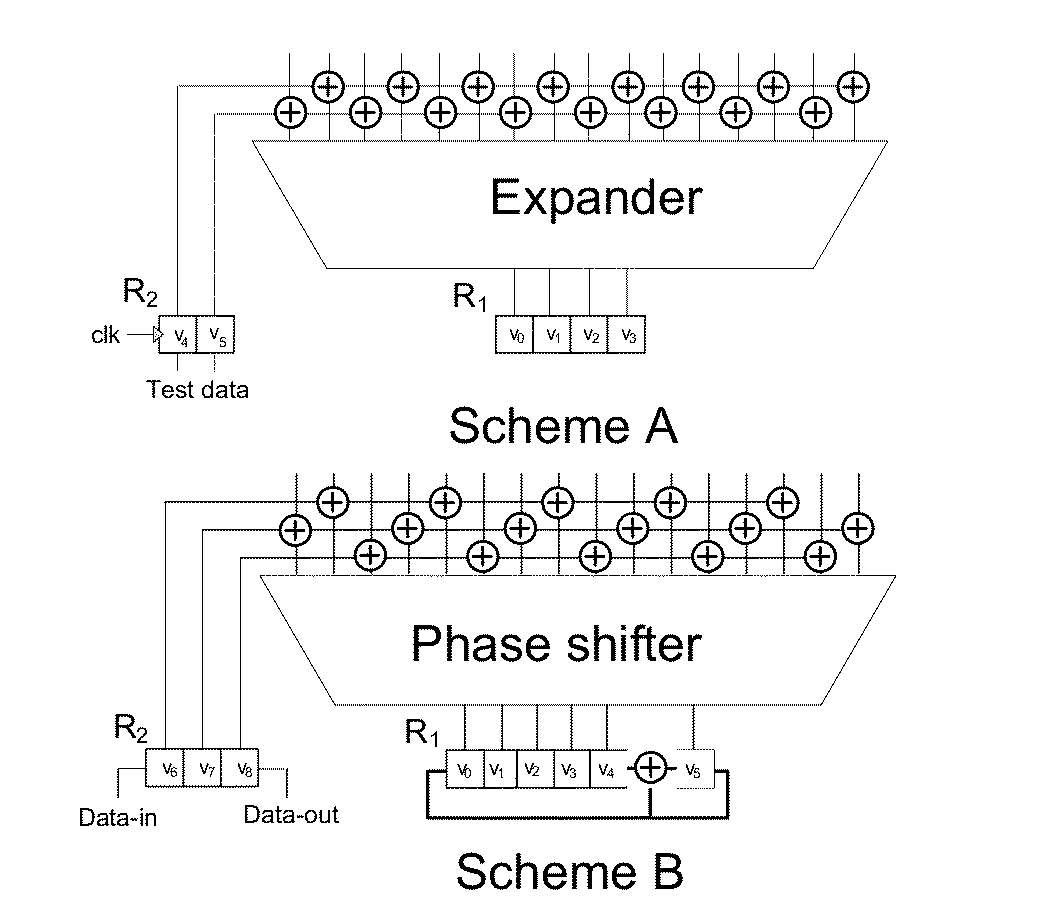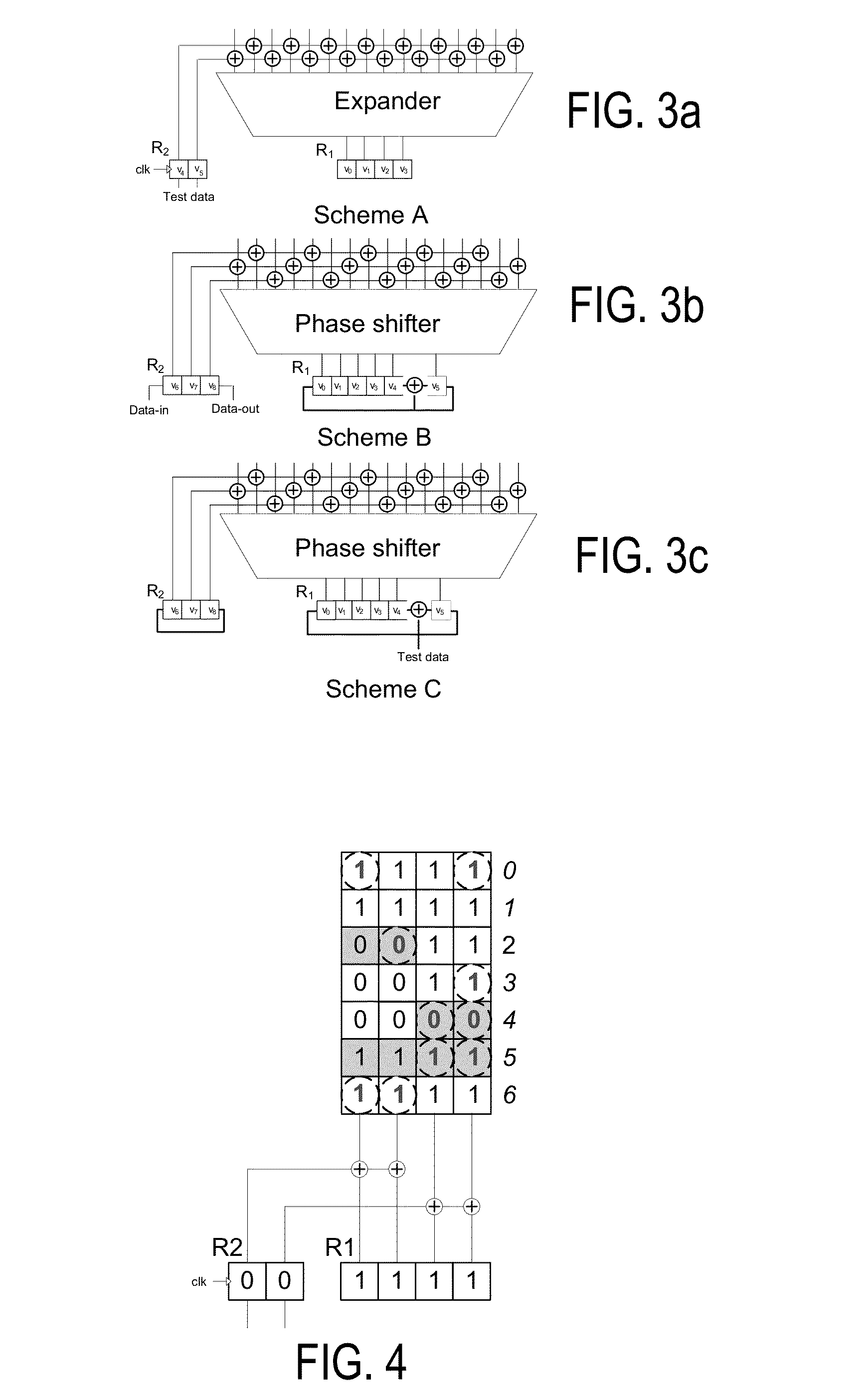Augmented power-aware decompressor
a power-aware, decompression technology, applied in the direction of individual semiconductor device testing, testing circuits, instruments, etc., can solve the problems of limiting the level of test data compression, inability to encode test cubes, negligible probability of not finding a solution (or having an encoding conflict), etc., to reduce the toggling rate of decompressed test stimuli
- Summary
- Abstract
- Description
- Claims
- Application Information
AI Technical Summary
Benefits of technology
Problems solved by technology
Method used
Image
Examples
example 1
[0069]FIG. 3 illustrates embodiments of the present invention. More formally, scheme A is a block diagram of a power-aware decompressor comprising two registers R1 and R2 of length n and m, respectively. Register R1 periodically receives static variables (or static seeds) from the tester. Register R2 selectively receives dynamic variables (or dynamic seeds) from the tester. As a result, the dynamic variables have a limited scope (typically a few consecutive shift cycles) while static variables are typically valid for one test pattern or n shift cycles. Also, the scope of the dynamic variables (dynamic seeds) may change in wide range for each pattern while the scope of the static variables (static seeds) is typically fixed for the whole pattern set. Next, registers R1 and R2 are coupled to the scan chains of a CUT by a logic network (or XOR expander) such that register R2 defines a partition. As a result, dynamic variables divide scan cells in the CUT into groups such that each group...
example 2
[0070]FIG. 5 shows another embodiment of the power-aware decompressor comprising a periodically reloadable register R1 and a selectively reloadable register R2 having two segments S1 and S2. In this embodiment, each of the segments comprises two or more memory elements such that each of the segments can independently receive dynamic seeds from the tester. In this case, two dynamic seeds are required to encode the highlighted care bits. More precisely, in shift cycle 0, 4-bit static seed 1001 is loaded in register R1 and both segments S1 and S2 are initialized to 00. In shift cycle 4, dynamic seed 01 is loaded in segment S1. In shift cycle 5, dynamic seed 01 is loaded in segment S2. The encoding ratio for this case is 1.25 since the number of the specified care bits is 10 and the number of required variables from the tester is 8. Also, the toggling rate is 0.167 since the decompressed test stimulus includes 4 out of 24 possible transitions.
example 3
[0071]FIG. 6 shows another embodiment of the power-aware decompressor comprising a periodically reloadable register R1 and two selectively reloadable segments S1 and S2 of register R2. In this embodiment, only one of these selectively reloadable segments can receive a dynamic seed from the tester per shift cycle, such that segment S2 can receive a dynamic seed in the current shift cycle from the tester if and only if segment S1 received the previous dynamic seed, and vice versa. The encoding ratio and toggling rate for this embodiment are 1.25 and 0.167, respectively.
PUM
 Login to View More
Login to View More Abstract
Description
Claims
Application Information
 Login to View More
Login to View More - R&D
- Intellectual Property
- Life Sciences
- Materials
- Tech Scout
- Unparalleled Data Quality
- Higher Quality Content
- 60% Fewer Hallucinations
Browse by: Latest US Patents, China's latest patents, Technical Efficacy Thesaurus, Application Domain, Technology Topic, Popular Technical Reports.
© 2025 PatSnap. All rights reserved.Legal|Privacy policy|Modern Slavery Act Transparency Statement|Sitemap|About US| Contact US: help@patsnap.com



